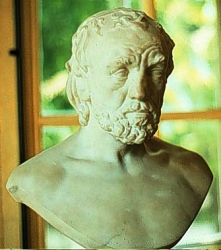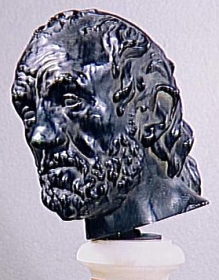Rodin Works: Mask of the Man with the Broken NOse |
|
Rainer Maria Rilke described the attractivity of the subject of the 'Mask' as follows: "One senses what had led Rodin to shape this head, the head of an aging and ugly man, whose broken nose only helps to intensify the tortured expression of his face. It was the fullness of life that was concentrated on these features; it was the fact that there was no symmetrical surface on this face at all, that nothing was repeated and no region remained empty, dumb or indifferent." In ..., Albert Elsen had the particular physiognomy of the face examined by a physician, who indictaed the broken nose had probably been caused by a fight, but contradicted Rilke's statement about the model's mature age:
There are still some relicts of the classical manner in the 'Mask', like the blank eyes - maybe to give the brutalized face a certain dignity; J.A. Schmoll points to the likeness of the 'Mask' to well-known representations of the legendary Greek poet Homer. The way Rodin modeled the hair bound in a fillet might have been an imitation of classical busts - but can also be interpreted as a referral to boxing sports. All in all, this uncouth realistic expression was innovative and opposed to the classical ideal; therefore, the Jury of the 1864 Salon rejected the 'Mask' immediately. In his conversations with Paul Gsell, Rodin defended the roughness of the 'Mask' as artistic beauty: "The vulgar readily imagine that what they consider ugly in existence is not fit subject for the artist …. It is a great error on their part. What is commonly called ugliness in nature can in art become full of great beauty."
Rainer Maria Rilke wrote about the 'Mask': "This face had not been touched by life, it had been afflicted with it, over and over, as though an implacable hand had held it down in fate as in the maelstrom of a rinsing, gnawing water. When one turns this mask in one’s hands, one is astonished by the continual shift of profiles, of which not one is accidental, approximate or undefined. There is no line, no overlap or contour on this face that Rodin had not seen and willed." [My italics - HdR] Rodin certainly would not have accepted any accident to determine the shape of his first work to be submitted to the Salon, if the effect would not have fitted his own artistic intentions. According to J. A. Schmoll, cropping the portrait to a mask would have intensified the expression of the face. Moreover, the form of a mask would have been easier and cheaper in casting. Finally, Carpeaux had demonstrated the possibilities of the mask form with his 'Portrait of Anna Foucar' in 1860 - only three years earlier. Whatever the cause for the reduction to a mask may have been, for the third submission to the Salon (the second overworked version was also rejected in 1865), Rodin re-worked the backside. In 1875, a completely overworked version in marble was shown in the Salon: the 'Mask' had become a complete bust again. This was the first time the Salon accepted one of Rodin's works and this greatly encouraged him. Three decades later, having reached the status of the most successful sculptor of his time, the artist looked back at the 'Mask' as his first major work:
"To execute a bust is to fight a long battle. The one
thing is not to weaken and to rest honest with one's self."
|
 In 1863, Rodin began the 'Mask of the Man with the Broken Nose' with the intention to submit it to the Salon as
a debut sculpture.
As a model, he had chosen a man of the neighbourhood named Bibi, of whom he was fascinated because of his clear-cut facial features and his broken nose.
In 1863, Rodin began the 'Mask of the Man with the Broken Nose' with the intention to submit it to the Salon as
a debut sculpture.
As a model, he had chosen a man of the neighbourhood named Bibi, of whom he was fascinated because of his clear-cut facial features and his broken nose.
 In later years, Rodin
also used to tell the anecdote that the bust he originally intended to
create had actually become a fragment,
because as a young artist, he could not afford to heat his studio overnight. During
a bitter cold winter night, the back of the
'Man with the Broken Nose' froze and broke off; this way from the bust only the
face was left. Rodin officially favoured such accidental damages - at
least he fancied these little stories introducing such elements of chance
and destiny, legitimizing his use of the fragment. In fact, as a skilled
artist and compulsive worker, he always strived for complete control over
his work.
In later years, Rodin
also used to tell the anecdote that the bust he originally intended to
create had actually become a fragment,
because as a young artist, he could not afford to heat his studio overnight. During
a bitter cold winter night, the back of the
'Man with the Broken Nose' froze and broke off; this way from the bust only the
face was left. Rodin officially favoured such accidental damages - at
least he fancied these little stories introducing such elements of chance
and destiny, legitimizing his use of the fragment. In fact, as a skilled
artist and compulsive worker, he always strived for complete control over
his work.